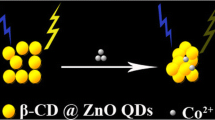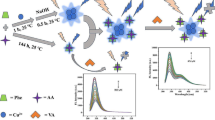Abstract
Based on the quenching of the fluorescence intensity of thioglycolic acid (TGA)-capped core-shell CdTe/ZnS nanoparticles (NPs) by vanillin, a novel, simple and rapid method for the determination of vanillin was proposed. In aqueous medium, the functionalized core-shell CdTe/ZnS NPs were successfully synthesized with TGA as the capping ligand. TGA-capped core-shell CdTe/ZnS NPs were characterized by using X-ray diffraction (XRD), transmission electron microscopy (TEM) and Fourier transform infrared (FTIR) spectroscopy. Factors affecting the vanillin detection were investigated, and the optimum conditions were also determined. Under the optimum conditions, the relative fluorescence intensity of CdTe/ZnS NPs was linearly proportional to vanillin over a concentration range from 9.4 × 10−7 to 5.2 × 10−4 M with a correlation coefficient of 0.998 and a detection limit of 2.6 × 10−7 M. The proposed method was also employed to detect trace vanillin in cookies with satisfactory results.








Similar content being viewed by others
References
Barghini P, Di Gioia D, Fava F, Ruzzi M (2007) Vanillin production using metabolically engineered Escherichia coli under non-growing conditions. Microb Cell Fact 6:13–23. doi:10.1186/1475-2859-6-13
Cava-Roda RM, Taboada-Rodríguez A, Valverde-Franco MT, Marín-Iniesta F (2012) Antimicrobial activity of vanillin and mixtures with cinnamon and clove essential oils in controlling listeria monocytogenes and escherichia coli O157:H7 in milk. Food Bioprocess Technol 5:2120–2131. doi:10.1007/s11947-010-0484-4
Waliszewski KN, Pardio VT, Ovando SL (2006) A simple and rapid HPLC technique for vanillin determination in alcohol extract. Food Chem 101:1059–1062. doi:10.1016/j.foodchem.2006.03.004
Tai A, Sawano T, Yazama F, Ito H (2011) Evaluation of antioxidant activity of vanillin by using multiple antioxidant assays. Biochim Biophys Acta 1810:170–177. doi:10.1016/j.bbagen.2010.11.004
Yoon SH, Li C, Lee YM, Lee SH, Kim SH, Choi MS, Seo WT, Yang JK, Kim JY, Kim SW (2005) Production of vanillin from ferulic acid using recombinant strains of escherichia coli. Biotechnol Bioproc Eng 10:378–384. doi:10.1007/BF02931859
Libardi SH, Borges JC, Skibsted LH, Cardoso DR (2011) Deactivation of ferrylmyoglobin by vanillin as affected by vanillin binding to β-lactoglobulin. J Agric Food Chem 59:6202–6208. doi:10.1021/jf1047173
Kayaci F, Uyar T (2012) Encapsulation of vanillin/cyclodextrin inclusion complex in electrospun polyvinyl alcohol (PVA) nanowebs: prolonged shelf-life and high temperature stability of vanillin. Food Chem 133:641–649. doi:10.1016/j.foodchem.2012.01.040
Hardcastle JL, Paterson CJ, Compton RG (2001) Biphasic sonoelectroanalysis: simultaneous extraction from, and determination of vanillin in food flavoring. Electroanalysis 13:899–905. doi:10.1002/1521-4109(200107)13:11<899::AID-ELAN899>3.0.CO;2-E
Farthing D, Sica D, Abernathy C, Fakhry I, Roberts JD, Abraham DJ, Swerdlow P (1999) High-performance liquid chromatographic method for determination of vanillin and vanillic acid in human plasma, red blood cells and urine. J Chromatogr B 726:303–307. doi:10.1016/S0378-4347(99)00031-6
Shang L, Zhao FQ, Zeng BZ (2014) Sensitive voltammetric determination of vanillin with an AuPd nanoparticles-graphene composite modified electrode. Food Chem 151:53–57. doi:10.1016/j.foodchem.2013.11.044
Ho KL, Chong PP, Yazan LS, Ismail M (2012) Vanillin differentially affects azoxymethane-injected rat colon carcinogenesis and gene expression. J Med Food 15:1096–1102. doi:10.1089/jmf.2012.2245
de Jager LS, Perfetti GA, Diachenko GW (2007) Determination of coumarin, vanillin, and ethyl vanillin in vanilla extract products: liquid chromatography mass spectrometry method development and validation studies. J Chromatogr A 1145:83–88. doi:10.1016/j.chroma.2007.01.039
Ohashi M, Omae H, Hashida M, Sowa Y, Imai S (2007) Determination of vanillin and related flavor compounds in cocoa drink by capillary electrophoresis. J Chromatogr A 1138:262–267. doi:10.1016/j.chroma.2006.10.031
Minematsu S, Xuan GS, Wu XZ (2013) Determination of vanillin in vanilla perfumes and air by capillary electrophoresis. J Environ Sci 25:S8–S14. doi:10.1016/S1001-0742(14)60617-3
Bettazzi F, Palchetti I, Sisalli S, Mascini M (2006) A disposable electrochemical sensor for vanillin detection. Anal Chem Acta 555:134–138. doi:10.1016/j.aca.2005.08.069
Zheng DY, Hu CG, Gan T, Dang XP, Hu SS (2010) Preparation and application of a novel vanillin sensor based on biosynthesis of Au-Ag alloy nanoparticles. Sensors Actuators B 148:247–252. doi:10.1016/j.snb.2010.04.031
Jiang L, Ding YP, Jiang F, Li L, Mo F (2014) Electrodeposited nitrogen-doped graphene/carbon nanotubes nanocomposite as enhancer for simultaneous and sensitive voltammetric determination of caffeine and vanillin. Anal Chim Acta 833:22–28. doi:10.1016/j.aca.2014.05.010
Takahashi M, Sakamaki S, Fujita A (2013) Simultaneous analysis of guaiacol and vanillin in a vanilla extract by using high-performance liquid chromatography with electrochemical detection. Biosci Biotechnol Biochem 77:595–600. doi:10.1271/bbb.120835
De Jager LS, Perfetti GA, Diachenko GW (2008) Comparison of headspace-SPME-GC-MS and LC-MS for the detection and quantification of coumarin, vanillin, and ethyl vanillin in vanilla extract products. Food Chem 107:1701–1709. doi:10.1016/j.foodchem.2007.09.070
Li L, Bian RX, Ding YP, Yu ML, Yu DW (2009) Application of functionalized ZnS nanoparticles to determinate uracil and thymine as a fluorescence probe. Mater Chem Phys 113:905–908. doi:10.1016/j.matchemphys.2008.08.050
Tang CR, Su ZH, Lin BG, Huang HW, Zeng YL, Shuang L, Huang H, Wang YJ, Li CX, Shen GL, Yu RQ (2010) A novel method for iodate determination using cadmium sulfide quantum dots as fluorescence probes. Anal Chim Acta 678:203–207. doi:10.1016/j.aca.2010.08.034
Dong F, Hu KW, Han HY, Liang JG (2009) A novel method for methimazole determination using CdSe quantum dots as fluorescence probes. Microchim Acta 165:195–201. doi:10.1007/s00604-008-0120-4
Fernández-Argüelles MT, Jin WJ, Costa-Fernández JM, Pereiro R, Sanz-Medel A (2005) Surface-modified CdSe quantum dots for the sensitive and selective determination of Cu(II) in aqueous solutions by luminescent measurements. Anal Chem Acta 549:20–25. doi:10.1016/j.aca.2005.06.013
Liu MM, Xu L, Cheng WQ, Zeng Y, Yan ZY (2008) Surface-modified CdS quantum dots as luminescent probes for sulfadiazine determination. Spectrochim Acta A 70:1198–1202. doi:10.1016/j.saa.2007.10.040
Liang JG, Huang S, Zeng DY, He ZK, Ji XH, Ai XP, Yang HX (2006) CdSe quantum dots as luminescent probes for spironolactone determination. Talanta 69:126–130. doi:10.1016/j.talanta.2005.09.004
Peng H, Zhang LJ, Soeller C, Travas-Sejdic J (2007) Preparation of water-soluble CdTe/CdS core/shell quantum dots with enhanced photostability. J Lumin 127:721–726. doi:10.1016/j.jlumin.2007.04.007
Wang BB, Shang H, Nie CP, Wang Q, Ma MH, Cai ZX (2013) A novel two-step controlled basic water phase method for synthesizing size-tunable CdTe/Cd(OH)2 core/shell quantum dots with high quantum yield and excellent stability. J Lumin 143:262–270. doi:10.1016/j.jlumin.2013.05.007
Sung TW, Lo YL (2012) Highly sensitive and selective sensor based on silica-coated CdSe/ZnS nanoparticles for Cu2+ ion detection. Sensors Actuators B 165:119–125. doi:10.1016/j.snb.2012.02.028
Zhang H, Zhou Z, Yang B, Gao MY (2003) The influence of carboxyl groups on the photoluminescence of mercaptocarboxylic acid-stabilized CdTe nanoparticles. J Phys Chem B 107:8–13. doi:10.1021/jp025910c
Li L, Cheng Y, Ding YP, Gu SQ, Zhang FF, Yu WJ (2013) Synthesis of functionalized core-shell CdTe/ZnS nanoparticles and their application as a fluorescence probe for norfloxacin determination. Eur J Inorg Chem 2013:2564–2570. doi:10.1002/ejic.201201372
El-sadek MSA, Babu SM (2010) Growth and optical characterization of colloidal CdTe nanoparticles capped by a bifunctional molecule. Phys B 405:3279–3283. doi:10.1016/j.physb.2010.04.060
Chen H, Li RB, Lin L, Guo GS, Lin JM (2010) Determination of L-ascorbic acid in human serum by chemiluminescence based on hydrogen peroxide-sodium hydrogen carbonate-CdSe/CdS quantum dots system. Talanta 81:1688–1696. doi:10.1016/j.talanta.2010.03.024
Lin WJ, Costa-Fernández JM, Pereiro R, Sanz-Medel A (2004) Surface-modified CdSe quantum dots as luminescent probes for cyanide determination. Anal Chim Acta 522:1–8. doi:10.1016/j.aca.2004.06.057
Baride A, Engebretson D, Berry MT, May PS (2013) Quenching of coumarin emission by CdSe and CdSe/ZnS quantum dots: implications for fluorescence reporting. J Lumin 141:99–105. doi:10.1016/j.jlumin.2013.03.027
Gudarzy F, Moghaddam AB, Mozaffari S, Ganjkhanlou Y, Kazemzad M, Zahed R, Bani F (2013) A lanthanide nanoparticle-based luminescent probe for folic acid. Microchim Acta 180:1257–1262. doi:10.1007/s00604-013-1050-3
Azab HA, Duerkop A, Saad EM, Awad FK, Abd El Aal RM, Kamel RM (2012) A novel luminescent terbium-3-carboxycoumarin probe for time-resolved fluorescence sensing of pesticides methomyl, aldicarb and prometryne. Spectrochim Acta A Mol Biomol Spectrosc 97:915–922. doi:10.1016/j.saa.2012.07.079
Chen J, Gao YC, Xu ZB, Wu GH, Chen YC, Zhu CQ (2006) A novel fluorescent array formercury (II) ion in aqueous solution with functionalised cadmium selanide nanoclusters. Anal Chim Acta 577:77–84. doi:10.1016/j.aca.2006.06.039
Timotheou-Potamia M, Calokerinos AC (2007) Chemiluminometric determination of vanillin in commercial vanillin products. Talanta 71:208–212. doi:10.1016/j.talanta.2006.03.046
Ni YN, Zhang GW, Kokot S (2005) Simultaneous spectrophotometric determination of maltol, ethyl maltol, vanillin and ethyl vanillin in foods by multivariate calibration and artificial neural networks. Food Chem 89:465–473. doi:10.1016/j.foodchem.2004.05.037
Yardim Y, Gülcan M, Sentürk Z (2013) Determination of vanillin in commercial food product by adsorptive stripping voltammetry using a boron-doped diamond electrode. Food Chem 141:1821–1827. doi:10.1016/j.foodchem.2013.04.085
Gao DY, Sheng ZH, Han HY (2010) A novel method for the analysis of calf thymus DNA based on CdTe quantum dots-Ru(bpy)3 2+ photoinduced electron transfer system. Microchim Acta 168:341–345. doi:10.1007/s00604-010-0289-1
Liu ZQ, Yin PF, Gong HP, Li PP, Wang XD, He YQ (2012) Determination of rifampicin based on fluorescence quenching of GSH capped CdTe/ZnS QDs. J Lumin 132:2482–2488. doi:10.1016/j.jlumin.2012.03.072
Wang XN, Liu R, Wang T, Wang BY, Xu Y, Wang H (2013) Dual roles of ZnS thin layers in significant photocurrent enhancement of ZnO/CdTe nanocable arrays photoanode. ACS Appl Mater Interfaces 5:3312–3316. doi:10.1021/am4003793
Acknowledgments
This research is supported by the National Natural Science Foundation of China (NSFC) (No. 21271127, 61171033), the Nano- Foundation of Science and Techniques Commission of Shanghai Municipality (No. 12nm0504200) and the Natural Science Foundation of Shanghai Municipality (No. 13ZR1415600).
Author information
Authors and Affiliations
Corresponding authors
Rights and permissions
About this article
Cite this article
Li, L., Zhang, Q., Ding, Y. et al. A Simple Fluorescence Quenching Method for the Determination of Vanillin Using TGA-capped CdTe/ZnS Nanoparticles as Probes. J Fluoresc 25, 897–905 (2015). https://doi.org/10.1007/s10895-015-1570-9
Received:
Accepted:
Published:
Issue Date:
DOI: https://doi.org/10.1007/s10895-015-1570-9




